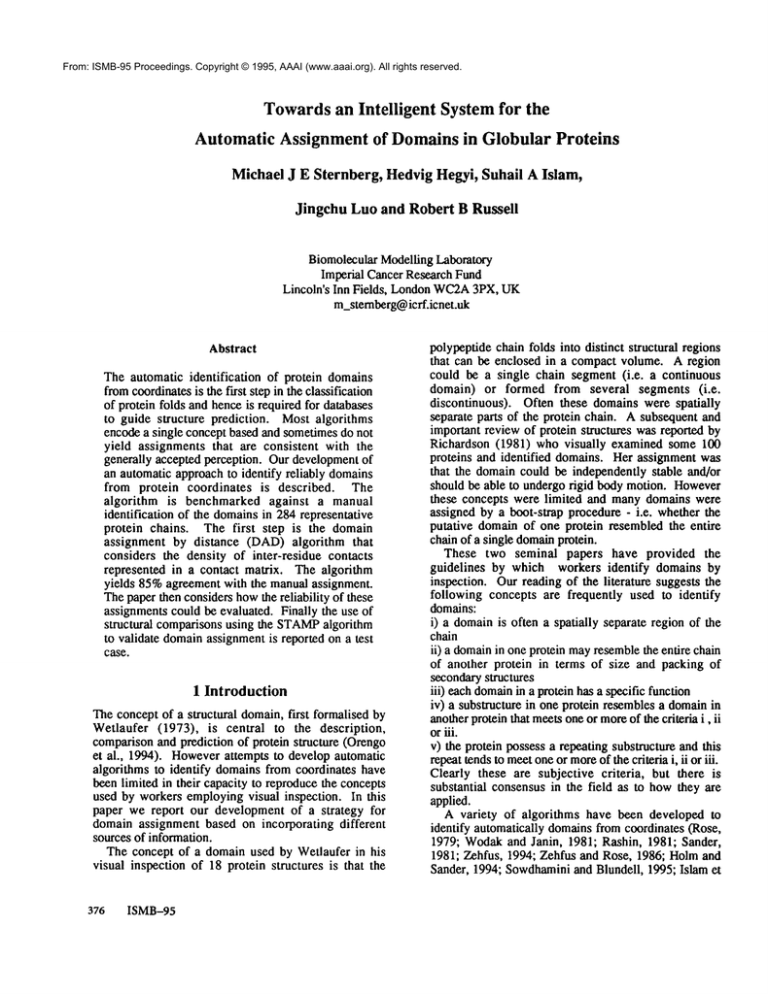
From: ISMB-95 Proceedings. Copyright © 1995, AAAI (www.aaai.org). All rights reserved.
Towardsan Intelligent
System for the
Automatic Assignment of Domains in Globular Proteins
MichaelJ E Sternberg,HedvigHegyi, Suhaii A Islam,
Jingchu Luoand RobertB Russell
Biomolecular Modelling Laboratory
Imperial Cancer Research Fund
Lincoln’s Inn Fields, London WC2A
3PX, UK
m_stemberg@icrf.icnet.uk
Abstract
The automatic identification of protein domains
fromcoordinatesis the first step in the classification
of protein folds and hence is required for databases
to guide structure prediction. Most algorithms
encode a single concept based and sometimesdo not
yield assignments that are consistent with the
generally accepted perception. Our development of
an automatic approach to identify reliably domains
from protein coordinates is described. The
algorithm is benchmarked against a manual
identification of the domainsin 284 representative
protein chains. The first step is the domain
assignment by distance (DAD) algorithm that
considers the density of inter-residue contacts
represented in a contact matrix. The algorithm
yields 85%agreement with the manual assignment.
The paper then considers howthe reliability of these
assignments could be evaluated. Finally the use of
structural comparisons using the STAMP
algorithm
to validate domainassignment is reported on a test
case,
1 Introduction
The concept of a structural domain, first formalised by
Wetlaufer (1973), is central to the description,
comparison and prediction of protein structure (Orengo
et al., 1994). Howeverattempts to develop automatic
algorithms to identify domains from coordinates have
been limited in their capacity to reproduce the concepts
used by workers employing visual inspection. In this
paper we report our development of a strategy for
domain assignment based on incorporating different
sources of information.
The concept of a domain used by Wetlaufer in his
visual inspection of 18 protein structures is that the
376
ISMB-95
polypeptide chain folds into distinct structural regions
that can be enclosed in a compact volume. A region
could be a single chain segment (i.e. a continuous
domain) or formed from several segments (i.e.
discontinuous). Often these domains were spatially
separate parts of the protein chain. A subsequent and
important review of protein structures was reported by
Richardson (1981) who visually examined some 100
proteins and identified domains. Her assignment was
that the domain could be independently stable and/or
should be able to undergo rigid body motion. However
these concepts were limited and many domains were
assigned by a boot-strap procedure - i.e. whether the
putative domain of one protein resembled the entire
chain of a single domainprotein.
These two seminal papers have provided the
guidelines by which workers identify domains by
inspection. Our reading of the literature suggests the
following concepts are frequently used to identify
domains:
i) a domainis often a spatially separate region of the
chain
ii) a domainin one protein mayresemblethe entire chain
of another protein in terms of size and packing of
secondary structures
iii) each domainin a protein has a specific function
iv) a substructure in one protein resembles a domainin
anotherprotein that meetsone or moreof the criteria i, ii
or iii.
v) the protein possess a repeating substructure and this
repeat tends to meetone or moreof the criteria i, ii or iii.
Clearly these are subjective criteria, but there is
substantial consensus in the field as to how they are
applied.
A variety of algorithms have been developed to
identify automatically domainsfrom coordinates (Rose,
1979; Wodakand Janin, 1981; Rashin, 1981; Sander,
1981; Zehfus, 1994; Zehfus and Rose, 1986; Holmand
Sander, 1994; Sowdhaminiand Blundell, 1995; Islam et
al., 1995; and in the QUANTA
modellingpackage). All
these approaches quantify concept (i) - the spatial
separation of domains.Noapproachconsistently yields
assignmentsthat concurwith the authors’ definitions.
Someof the algorithmrepeatedly cuts the chain leading
to small segments.In others the algorithmhas not been
benchmarkedas to its agreement with the domain
assignments
in the literature.
Domainassignment1
by DAD
algorithm
which of the domain assignments from the DAD
algorithmare reliable andwhichneedfurther validation.
Thethird step recognisesthat domainscan also be
definedby structuralsimilarity. Wepropose
the useof a
structure comparison algorithm to aid domain
assignmenL
Theaim is that domainsthat are confidently
assigned by the DAD
algorithm can be comparedto a
databaseof structures to find similarities. Weshowhow
structure comparison can reveal domains which,
althoughsimilar in three-dimensionalstructure, do not
necessarily occur as spatially distinct units. Wethus
explore howconcept (iv) can be included into the
approach. Thus our goal is to develop tools that can
reliably parsethe proteincoordinatesets to yield accurate
domainassignmentsby incorIxration of different sources
of information.
2 Methods
2.1 Data set of domainassignments from the
literature
Figure 1 - Flow chart of domain assignment
Our aim is to develop an automatic algorithm for
domain assignment that incorporates the concepts
actually used by workers(see Figurel). Westart with
our computeralgorithm(DAD)(Islam et al., 1995)
automaticallyidentifies domainsfromcoordinatesbased
on concept(i). DAD
is basedin inter-residue distances
and uses the contact plot methodof Sander(1981). The
results of this automatic approachare comparedto a
manual assignment of domains obtained from the
literature and graphics inspection. Weshowthat an
accuracyof 85%can be achievedby this approach. The
next step is to developcomputationaltools to identify
Thedataset consisted of 284 protein chains basedon the
301 non redundant list of chains developedby Hobohm
and Sander (1994). The list was based on coordinates
available from the October 1993 release of the
Brookhavendatabank (Bernstein et al., 1977). (Two
proteins in their list each consistedof two chains that
were merged into a single set. Coordinates were
unavailable for the remaining 15 chains.) Wethen
followed Richardson’s (1981) concept of domainsand
inspectedthe literature for authorsassignmentsthat, in
our opinion, used similar concepts. Generallywewere
able to use the authors’ definitions but sometimeswe
employed
visual inspection on the graphicsusing our inhouse program PREPI( S A Islam, unpublished but
available on reques0. In somechains, weidentified the
end of one domainand the start of the next domain
omittingthe linking regionthat couldnot be assignedto
either domain.
2.2 DomainAssignment by Distance (DAD)
Algorithm
The domainassignment by a distance (DAD)algorithm
cuts the chain into segmentto minimisethe density of
inter-domaincontactsin the contactplot.
Step 1 - Generationof a contactmatrix
Considera chain segmentfrom residue a to b ( for
completechain of N residues a=l, b=N). For residues
andj , the entry in the contact matrix Dij is 1 if the
carbon cx- carbon ct distance is less than a cut off
Steinberg
377
distance d, or 0 otherwise. In a graphical representation
of the matrix a point is plotted at ij if Dij =1. Figure 2
shows an actual example of a domain contact map for
alcohol dehydrogenase(8adh, Eklundet al., 1976).
Let the chain is divided into two domain a to k and
k+l to b, then the numberof inter-domain contacts Ck, is
given by"
k
Ck=
b
~ ~=,
Dij
i=a j=k+l
wherek is an index denoting the cut position.
The maximumnumberof possible inter-domain contacts,
Mkis given by:
Mk = (k-a+l)
The density of contact Sk is defined as Ck divided by the
maximumand is:
Sk = Ck/Mk
e) In addition, any segmentof less than 32 residues is
merged with the next section along the chain that is
longer than 31 residues. A segment of less than 32
residues at the C-terminus is merged with the nearest
preceding segmentof more than 31 residues. As a result
of this merging procedure, the algorithm will only
identify domainslonger than 31 residues.
The agreement between the program’s assignments and
the authors’ assignmentsis taken as an accuracy score of
the DADalgorithm QD:
QD= (Ncorrect/Ntotal)
Step 2 - Division of the chain
Calculate the value of Sk for k = a to b. Apotential cut to
the chain is made at the minimumvalue of Sk for k
between a+15 and b - 15. To determine whether the
chain should be subdivided, the average (Aab) of Sk
then calculated by:
b
1)
and a division madeonly if
Sk/Aa, b < F
where F is a cut-off value to be determinedempirically.
Step 3 - Clustering into discontinuous segments
Step 2 yields a series of continuous chain segments each
of which is a potential domain. Twoor more of these
segments might together form a discontinuous domain
which is identified using the following clustering
algorithm.
a) For every pair of continuous segments, calculate the
value of Sk / A1,N.
b) Store these values in a matrix X as a percentage.
378 ISMB--95
d)This procedureis repeated until no further clustering of
segmentsis allowed.
Step 4 - Evaluation of Accuracy
(b-k)
Aa, b = ~ S k / (b-a+
k=a
c) Identify the maximum
entry in X and if greater than F,
then the corresponding two segments (say p and q) are
assigned to the same domain, and the values in X is
updated to include the assignmentof segmentsp and q to
the same domain.
x 100%
where Ncorrect is the numberof residues identified in
the authors’ assignment as belonging to a particular
domain that were correctly assigned to that domain by
the program. A linking region in the authors’ assignment
is always taken as being correctly identified by the
program. Ntota I is the maximumvalue that could he
obtained for Ncorrect. A domainassignment to a protein
is only considered correct if the number of domains
found by the programis equal to the numberof authorassigned domains and the accuracy QD> 95%.
Runs of the program were performed for d ranging
between 6.5 and 13 A in steps of 0.5A and for F from 40
to 65%in steps of 5%to obtain the optimumvalues for
these two adjustable parameters assessed by the
accuracy. The values selected are d = llA and F = 55%.
Legendto Figure 2 (next page) - Illustration of the DAD
algorithm. 2a - A schematic diagram of 8adh (alcohol
dehydrogenase, (Eklund et al., 1976)) showing
domaincuts according to the authors’. 2b - The distance
plot with the running value of Sk and its average A1,N.
Belowthe plot is the secondary structure with arrows as
the I~-strands, rectangles as or-helices. The next line
shows the cuts made. The final line gives the domain
assignment after clustering. Fig 2c - Details of the
cutting and clustering procedure. The table is the X
matrix so the first clustering is performed between
segments S1 and $3; subsequent clusterings are not
shown.
o
Sternberg
379
2.3 Structural ComparisonAlgorithm- STAMP
Structure comparisonswere perfom-~edusing the STAMP
package(Russell and Barton, 1992). Briefly, the method
uses an initial alignmentof query(search) and database
structures to derive an initial superimposition,whichis
then refined to give an accurate set of structurally
equivalentresidues. Thequerysequenceis overlayedon
to the databasesequencestarting at every 5th database
residue. The aligned (equivalenced) Ca atomsare used
to derivean initial fit (superimposition),
whichis refined
first by a conformationbiased fit, then by a combined
distance and conformationfit. Dynamicprogramming
is
used to provide a final set of structurally equivalent
residues, andan overall structural similarity score (Qs).
In this study, QSwasdef’medas:
QS= (T/Lq) (Lq- Gq)/Lq
WhereT is the sumof residue similarities returned by
dynamicprogramming,Lq is the length of the query
structure (in residues), and Gqis the numberof query
residues alignedto a gapin the structural alignment.QS
values of greater than 2.5 generally suggest structural
similarity with strong similarities yielding scores above
3.5. The (Lq-Gq)/Lqterm penalises those structural
alignmentsnot containing a significant portion of the
querystructure(i.e. short, local similarities not implying
overall structural similarity). This scoring schemewas
chosenbecausesimilarities involvingsmall portions of
the querydomainare unlikely to aid domainassignment.
This method has been used to detect several
previouslyun-noticedsimilarities betweenprotein threedimensionalstructures. Similarities havebeendetected
between:a) the SH2domainanddomainII of E. coli bit
operon protein(Russell and Barton, 1993); b) between
HIVmatrixprotein p17 andinterferon ? (Matthews
et al.,
1994); c) betweendomainB of disulphide bondforming
protein and the C-terminal domain of thermolysin
(Russell, 1994); and betweenthe smaller domainfrom
viral coat protein VP7andphaseolin(Russell, 1994).
3 Results
3.1 The DADAlgorithm
Table 1 gives the agreement between the domain
definition by the authors’ andthe identification by DAD
algorithmfor the representativeset of 284proteins using
the optimal choiceof d andF. Wereported twoscores the numberof times the DAD
algorithm and the authors
concuras to the numberof domainsand also imposingin
addition the stricter criterion of an accuracyQDof >_
95%. With the stricter requirement, the domain
assignmentsof 222 of the 284 chains (i.e. 78%)were
correctly identified by the algorithm.182out of the 197
single domains(i.e. 92%)werecorrectly identified and
39 of the 67 two domains(i.e. 58%)wereidentified with
38O ISMB-95
QD> 95%.Theidentification of chains split into three
or moredomainswaspoorer. Full details of the authors’
and the DADprogram’s assignment of domains are
availableuponrequestfromus.
The assignment of domains according to our
interpretation of the authors’ description( occasionally
supplemented
by inspectionof the graphics)is of course
subjective. Weexaminedin detail every chain for which
there was a disagreement between the number of
domainsassigned by the authors and the program.For
15 chains inspection suggested that there was an
acceptable alternative definition as to the numberof
domainsin the protein chain whichwasconsistent with
the results of the algorithm. For a further four chains
although the numberof domainswas the same,there was
an alternative segmentdefinition. In addition, there was
one protein (code laaf - HIVnucleocapsidprotein) that
was non globular and so the usual concept of domain
does not apply. If the programis consideredcorrect for
these 20 chains, the final accuracyis 242 out of 284
chains(i.e.85%).
Inspectionof the structuresof the chainsfor whichthe
DAD
algorithm failed showeda variety of reasons for
the errors. Afrequent difficulty wasthat the domainwas
compactbut wasnot spatially separate fromthe rest of
the protein. This could be clearly seen in the
identification of the dinucleotide binding domain
(DNBD)
(Rossmannet al., 1974). This domainconsists
of at least six parallel 13-strandswith order321456where
mostof the right-handedconnections are l~ctl3 units
(Richardson, 1976; Sternberg and Thornton,1976).
both 8ate (aspartate carbamoyltransferasechain A) and
in 61dh(lactate dehydrogenase)the algorithm did not
identify this dinucleotide domaindue to close packing
with other parts of the chain. In conWast,the domainwas
identified in (lhsd) hydroxysteroiddehydrogenase,
8adh
(alcohol dehydrogenase),in 4gpd(glyeeraldehyde
phosphatedehydrogenase)
and as part of a larger domain
in lgpb (glycogenphosphorylase).
Wehave compared (see Islam et al, 1995) our
assignmentswith those of other workers (Rose, 1979;
Rashin 1981;Wod_ak
and Janin, 1981; Sander, 1981;
Holmand Sander, 1994; Sowdhaminiand Blundell,
1995).In generalthe locations of the cuts agreeandthe
maindifference is the decision whetherto cut the chain
or not. Wenote that Holmand Sander (1994) correctly
identify the domainstructure (our interpretation of the
authors’ assignment) of 8adh, 8ate and4glxl but not of
61dh,lhsd and lgpb.
3.2 Tools for confidence of assignment by DAD
To be useful for automatically parsing protein
coordinates, one needs to knowwhether a particular
DADassignment is expected to be accurate. Weare
exploring the following approaches to estimate the
expectedaccuracy.
i) A single inter-residue distance (d) and cut off value
(F) were used by the DADalgorithm. Weare evaluating
whether a consistent definition resulting from runs at
different cut offs provides a guide to reliability. For
examplethe program yielded consistent results on 8adh
over a range of d from 6 to 13 A suggesting a confident
assignmenCIn addition, often a different choice of these
parameters would have yielded the authors’ assignment.
Thus a range of these parameters can be used to yield
alternative definitions for subsequentselection.
ii) The value of the cut (Sk / Aa,b) could provide
further insight into reliability. Forthe first putative cut, a
high suggests that the chain can reliably be considered a
No of domains
in chain with
its frequency
in authors’
single domain. Similarly if the DADalgorithm only
implements one cut with a low value, this suggests two
clearly
se.parate
domains.
iii) An alternative approach for domainassignmentis
to cluster secondary structures
(Sowdhamini and
Blundell, 1995; and QUANTA).
Inspection of these
results suggests that often the domainis formed from
several discontinuous regions which leads to differences
from most author’s assignments. However if the two
algorithms agree, the assignment could be considered
reliable.
No of domains assigned by DAD algoritm
1
197
15
0
0
0
2
67
45(39)
2
0
0
3
13
4
8
i(I)
0
0
4
6
0
5
1
0(0)
0
5
1
0
1
0
0
0(0)
182 (182)
20
Table 1 - Accuracy of domain assignment by DADalgorithm
The entries denote the numberof times a chain is split into a given numberof domainsby the authors’ and a
given numberby the DADalgorithm. Numbersin brackets refer to when the algorithm both agrees as to
number of domains and yields an accuracy QD> 95%
3.3 Domain assignment by structural
comparison
(STAMP)
The observation on the identification of the dinucleotide
binding domain (DNBD)highlights that often one can
readily identify a domainin one chain by virtue of its
compactness and spatial separation. The presence of a
similar substructure in another chain that is less spatially
separate should also be identified as a domain. We
explored whether recognition of structural similarity
between an identified domainand substructures within
chains could be used to test the internal consistency of
the DADalgorithm for domain assignment.
Here we report one test case. Westarted with the
algorithm’s assignment of the dinucleotide binding
domain in 8adh (residues 175 to 322). This assignment
wouldhave been found throughout the range of d values
from 6 to 13A and would thus be considered as a
confident assignment. This domain was compared
structurally
using STAMP
with every other protein
chain.
Sternberg
381
For each probe protein chain:
a) The score for structural equivalence was calculated
(Qs)
b) For each domain assigned by the DADalgorithm
i) Calculate the total numberof residues in the
domain (Nd)
ii) Identify the numberof residues in the domain
that were structurally equivalencedto the protein
chain (Nsd)
iii) hence evaluate the fraction of the numberof
residues in the domainthat were equivalenced to
the probe chain (Nsd / Nd)
c) For each domainassigned by the authors
i) Calculate the total numberof residues in the
domain (Na)
ii) Identify the numberof residues in the domain
that were structurally equivalencedto the protein
chain (Nsa)
iii) henceevaluate the fraction of the numberof
residues in the domainthat were equivalenced to
the probe chain (Nsa / Na)
above this score one can be confident that the structural
equivalence has identified a close similarity between
substantial segmentsof the chain. Table 2 also gives the
accuracy score (QD) comparing the DADalgorithm with
the authors’ assignments. WheneverNsd/Nd< 0.67, the
DADalgorithm had previously correctly identified the
domain. This is because the size of the segment(s) found
by STAMP
to be structurally equivalence to the DNBD
of 8adh is not much less than the total number of
residues in the segment identified as a domainby DAD.
In contrast, wheneverNsd/N
d < 0.5, the DADalgorithm
failed to split the chain into domains whereas STAMP
found that only part of the chain could be equivalenced
to the DNBD
of 8adh. The best examples are that the
six-stranded
DNBD of 8ate
(aspartate
carbamoyltransferase)
and of 61dh (lactate
dehydrogenase) are identified by STAMP
but were not
identified by DAD.The other examples in the Table in
which STAMP
finds a domain previously not identified
by DAD
are of folds with five IS-strands with or-helical
connections that have the same topology as five of the
six strands of the DNBD.
Table 2 gives the results for scores of QS_>3.5. Previous
experience with structural comparisons suggested that
Protein
+chain
code
STAMP
score
QS
STAMP with
DAD
Nsd
Nsd/Nd
Acc
DAD
%
QD
STAMP with
author
Nsa
Nsa/Na
STAMP finds
lhsdA
8atcA
8abp
idri
iminA
iminB
3gbp
61dh
lwsyB
4gpdl
4
4
4
4
4
4
4
4
3
3
177
143
142
128
98
104
143
139
105
116
i00
-1
97
95
-i
-i
98
-i
-i
90
177
134
142
128
98
103
143
139
105
145
DNBD &
DNBD &
Related
Related
Related
Related
Related
DNBD &
Related
DNBD &
81
71
70
43
16
13
05
02
98
52
0.69
0.46
0.84
0.95
0.21
0.21
0.87
0.42
0.27
0.98
0.69
0.95
0.85
0.92
0.66
0.65
0.88
0.85
0.65
0.98
agrees DAD
corrects DAD
fold & agrees DAD
fold & agrees DAD
fold & corrects DAD
fold & corrects DAD
fold & agrees DAD
corrects DAD
fold & corrects DAD
roughly agrees DAD
Table 2 - Domainassignment by structural comparision
Protein chains are: lhsd 0aydroxysteroiddehydrogenase);8atc (aspartate carbamoyltransferase); 8abp (L-arabinose
binding protein); ldri (D-ribose binding protein); lmin (nitrogenase molybdenum-iron
protein); 3gpb (galactose
binding protein); 61dh (lactate dehydrogeanase); lwsy (tryptophan synthase); 4gpd (glyceraldehyde 3-phosphate
dehydrogenase).
382
ISMB-95
4 Discussion and Conclusion
Given the rapid increase in the number of protein
coordinates, it is becomingessential to develop tools to
identify structural features. The assignment of domains
is central to comparative taxonomyand to prediction of
folds by threading (Orengo et al., 1994). Whilst manual
assignments are of course subjective, we consider that
they still reflect manyconcepts that are useful. The
presently-available algorithm for domainidentification
implementa single concept and do not yield assignments
that concur sufficiently with manualassignments. In this
paper we show that structural comparisons can augment
an algorithm based on spatial separation. The different
sources of information that need to be encapsulated in
manual domain identification
pose a challenge for
algorithm developmenL
References
Bernstein, F. C., Koetzle, T. F., Williams, G., Meyer, D.
J., Brice, M. D., Rodgers, J. R., Kennard, O.,
Shimanouchi, T. and Tasumi, M. 1977) The protein data
bank: a computer-basedarchival file for macromolecular
structures. J. Mol. Biol. 112, 535-542.
Ekhnd, H., Nordstrom, B., Zeppezauer, E., Soderlund,
G., Ohlsson, I., Boiwe, T., Soderberg, B.-O., Tapia, O.,
Branden, C.-I. and Akeson, A. 1976. Three-dimensional
structure of horse liver alcohol dehydrogenaseat 2.4A
resolution. J.MoLBiol. 102, 27-59.
Hobohm, U. and Sander,
C. 1994. Enlarged
representative set of protein structures. Prot. Sci. 3,522524.
Holm,L. and Sander, C. 1994. Parser for protein folding
units. Proteins 19, 256-268.
Islam, S. A., Luo, J. and Sternberg, M. J. E. 1995.
Identification
and analysis of domains in proteins.
Protein Engineeringin the press.
Matthews,S., Barlow, P., Boyd, J., Barton, R., Russell,
R., Mills, H., Cunningham,M., Meyers, N., Burns, N.,
Clark, N., Kingsman,S., Kingsman,A. and Campbell, I.
D. 1994. Three-dimensionai structure of HIV-1 matrix
protein p17 reveals similarity to interferon-g. Nature
370, 666-668.
Orengo, C. A., Jones, D. T. and Thornton, J. M. 1994.
Protein superfamilies and domain superfolds. Nature
372, 631-634.
QUANTA.
Molecular Simulations Inc, Waltham, Mass
USA.
Rashin, A.A. 1981) Nature 291, 167-339.
Richardson, J. S. 1976. Handedness of crossover
connections in beta sheets. Proc Nat Acad Sci , USA
73, 2619-2623.
Richardson, J. S. 1981. The anatomy and taxonomy of
protein structure. Adv. Protein Chem.34, 167-339.
Rose, G. D. 1979. Hierarchic organiT~tion of domainsin
globular proteins. J. Mol. Biol. 134,447-470.
Rossmann, M. G., Moras, D. and Olsen, K. W. 1994.
Chemical and biological evolution of a nucleotidebinding protein. Nature 250, 194-199.
Russell, R. B. 1994. Domain insertion.
Protein
Engineering 7, 1407-1410.
Russell, R. B. and Barton, G. J. 1992. Multiple sequence
alignment from tertiary structure comparison: assignment
of global and residue confidence levels. Proteins 14,
309-323.
Russell, R. B. and Barton, G. J. 1993. An SH2-SH3
domainhybrid. Nature 364, 765.
Sander, C. 1981. Physical criteria for folding units of
globular proteins. In Structural Aspects of Recognition
and Assembly in Biological Macromolecules, ed.
Balaban, M., Sussman, J. L., Traub, W. and Yonath, A.,
Balaban ISS, Rehovotand Philadelphia. pp. 183-195
Sowdhamini,R. and Blundell, T. L. 1995. An automatic
methodinvolving cluster analysis ofsecondary structures
for the identification of domainsin proteins. Protein
Science in the press,
Sternberg, M. J. E. and Thornton, J. M. 1976. On the
conformation of proteins: the handedness of the betastrand / alpha-helix / beta-strand unit. J Mol Bioi 105,
367-382.
Wedaufer, D. B. 1973. Nucleation, rapid folding, and
globular intrachain regions in proteins. Proc. Natl. Acad.
Sci. USA70, 697-701.
Wodak,S.J. and Janin, J. 1981. I.~¢ation of structural
domainsin proteins. Biochemistry 20, 6544-6552.
Zehfus, M. H. 1994. Binary discontinuous compact
protein domains. Prot.ein Engineering. 7, 335-340.
Zehfus, M. H. and Rose, G. D. 1986. Compactunits in
proteins. Biochemistry 25, 5759-5765.





